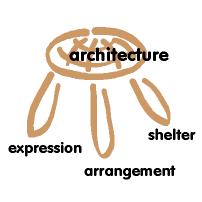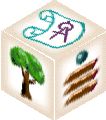|
| ||
| Final |
• Matt Taylor Studio Project •
• Pattern Language •
• Xanadu Project •
Basic Architectural Practice

Bibliography and Biographies
The following books constitute a key resource for understanding the content of this course. They are ordered below more or less in sequence with the introduction of the concepts they correspond to. The list will grow as we proceed through the sessions.
Without the background presented in these books a robust understanding of what I am saying will be compromised. I encourage you to get, at least, to a familiarity level with each of these writers. This requires about one hour per book.
| Author | Title | Publisher | Notes |
| Christopher Alexander | A Pattern Language A Timeless Way of Building | The basic patterns that make enduring architecture. A great audit of what elements make up the human habitat. A Timeless Way explores the relationship between how buildings are produced and the result. A strong case for by design, development and building cannot be separated.
| |
| Norbert Weiner | Cybernetics The Human Use of Human Beings | The father of Cybernetics describes the historical and technical foundations of the science. Feedback and other critical terms are defined. Essential stuff to the understanding of complex and dynamic systems.
| |
| Jaque Barzun | The House of Intelect | The House of Intellect was written in 1956 and, unfortunately, has proven to be an accurate forcast of the tradition of intellect in today’s society. Barzun argues that we destroying intellect both at it’s roots and by our miss application of it. A compelling book - and a warning now mostly proven out.
| |
| Ching | This is a basic course in architecture techniques, as well as, a great review of architectural history. Ching outlines and illustrates the physical elements that make up a building - the are the “notes” that make up architecture as “frozen music.” The book is also an exemplary piece of presentation and illustration.
| ||
| Rand |
| Rand lays out her theory of art and she conceived and practiced it. A clear exposition of the many aspects that make art what it is.
| |
| Jef Raskin | The Humane Interface | Every transition introduces the issue of interface. Walking from one room to another, a light switch, going in or out of a structure. Jef’s work covers mostly computers and consumer products, however, the principles apply to the built environment as well - this is too often neglected in modern design.
| |
| Jane Jacobs | Cities and the Wealth of Nations The Nature of Economics | Jan Jacobs pointed out how housing projects destroyed community and thus themselves. She developed the thesis that it was cites that fostered the development of agriculture - not the other way around. In these two works she argues that cities are the source of wealth not nations, that “replacement” cites are necessary to maintain viability and that economics, in the end, follows the same ecological principles as nature does.
| |
| Sim Van Der Ryn Stuart Cowan | Ecological Design | Island Press | Sim and Stuart present a systematic approach to ecological design. Working this way at some scale will make a much needed revolution across out entire global economy. The structure presented here is practical, will pay as it goes, and it will facilitate our transition to a sustainable economy/ecology.
|
| Paul Hawken | The Ecology of Commerce | Hawken rejects the dichotomy between ecology and economics two concepts which come from the same root. He explores new business models and defines means for repairing the damage this split has caused. Life-cycle economics are introduced.
| |
| Ian MacHarg | Design With Nature | A classic work as relevant to as when it was published in the 70’s. Full of methods that can be done, today, easily with modern data bases and media displays. | |
| Mavin Minsky | The Society of Mind | ||
| Ron Kurtzweil | The Age of Spiritual Machines | ||
| Stuard Brand | How Buildings Learn | ||
| Eugene Tsui | Evolutionary Architecture | John Wiley & Sons | |
| Janine M Benyus | Biomimicry | William Morrow and Company |
These are not books to read once and put away. These are ideas to be be absorbed and applied. Let them be your companions. These are the voice of those who have defined paths to a better architecture and it’s practice. These book documents and captures a portion of their passion, commitment, history and accomplishments. Together, with your active Syntopical reading (see: Adler How To Read a Book), they make a rich knowledge-base for your exploration.
Matt Taylor
In Flight - San Francisco to Princeton N.J.
October 12, 2000

SolutionBox voice of this document:
IDENTITY • PHILOSOPHY • CONTRACT DOCUMENT
posted: October 12, 2000
revised: October 13, 2000
• 20001012.294521.mt • 20001013.264985.mt
This document is 5% finished
Copyright© 2000 Matt Taylor
|
| ||
| Bib % Bio | Final |
• Matt Taylor Studio Project •
• Pattern Language •
• Xanadu Project •